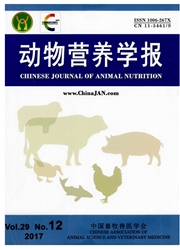

 中文摘要:
中文摘要:
本试验旨在研究调质温度和粉碎粒度对肉鸡生长性能及养分表观利用率的影响。以玉米-杂粕型全价配合饲料为肉鸡试验饲粮,选取1.5、2.0、2.5和3.0 mm 4个不同的筛片孔径,75和85℃2个调质温度。选用864只1日龄爱拔益加(AA)肉仔鸡随机分为8个组,每个组6个重复,每个重复18只鸡,试验期6周。结果表明:1-3周(前期)各组间干物质表观利用率和粗蛋白质表观利用率差异均不显著(P〉0.05),调质温度和粉碎粒度及其交互作用对4-6周(后期)干物质表观利用率和粗蛋白质表观利用率产生显著影响(P〈0.05);调质温度对前期末重、平均日采食量和平均日增重均产生显著影响(P〈0.05),粉碎粒度对前期末重、平均日采食量、平均日增重和后期末重、平均日增重及全期平均日增重均产生显著影响(P〈0.05)。后期平均日采食量和料重比组间差异均不显著(P〉0.05)。综合得出,粉碎粒度对肉鸡的生长性能和养分表观利用率影响显著,为了降低加工能耗,肉鸡前期饲粮调质温度应选择85℃、粉碎粒度选择911μm(粉碎机筛片孔径3.0mm);肉鸡后期饲粮调质温度应选择75℃、粉碎粒度选择901μm(粉碎机筛片孔径选择3.0mm)。
 英文摘要:
英文摘要:
This research was aimed to study the effects of different conditioning temperatures and particle sizes on growth performance and nutrient apparent utilization of broilers. This test was designed by corn-miscellane- ous meals poultry complete compound feed for the test material. Four different sieve pore sizes ( 1.5, 2.0, 2.5, 3.0 mm) and 2 different conditioning temperatures (75, 85 ℃ ) were selected. A total of 864 one-day-old Arbor Acres (AA) broilers were randomly divided to 8 groups with 6 replicates per group and 18 broilers per replicate. The experiment lasted for 6 weeks. The results show as follow : early period ( 1 to 3 weeks), apparent utilizations of dry matter and crude protein were not significantly different among all groups (P〉0.05). Later period ( 1 to 3 weeks), apparent utilizations of dry matter and crude protein were significantly affected by conditioning temperature, particle size and interaction of them (P〈0.05). Final body weight, average daily gain and average daily feed intake of early period were significantly affected by condition temperature (P〈0.05). Final body weight, average daily gain and average daily feed intake of early period, final body weight and average daily gain of later period, and average daily gain of whole period were significantly affected by particle size (P〈0.05). The average daily feed intake and feed to gain ratio of later period were not significantly different among all groups (P〉0.05). In conclusion, the growth performance and nutrient apparent utilization of broilers are significant impacted by particle size. In order to reduce energy consumption of processing, poultry feed appropriate condition temperature should be 85 ℃, particle size should be 911 μm ( sieve pore size of grinder is 3.0 mm) of early period; and appropriate condition temperature should be 75 ℃, particle size should be 901 μm (sieve pore size of grinder is 3.0 mm) of later period.
 同期刊论文项目
同期刊论文项目
 同项目期刊论文
同项目期刊论文
 期刊信息
期刊信息
